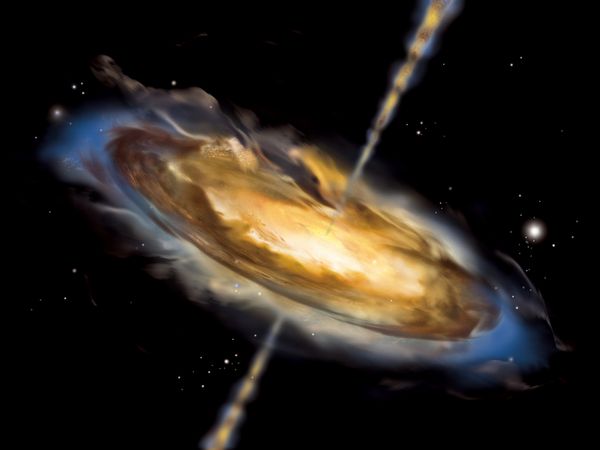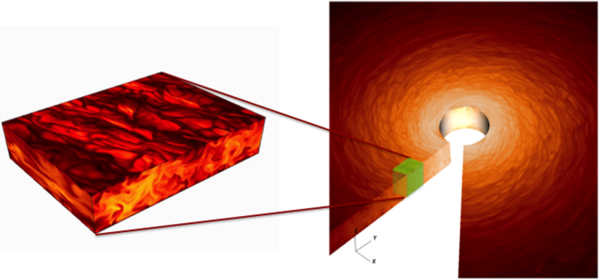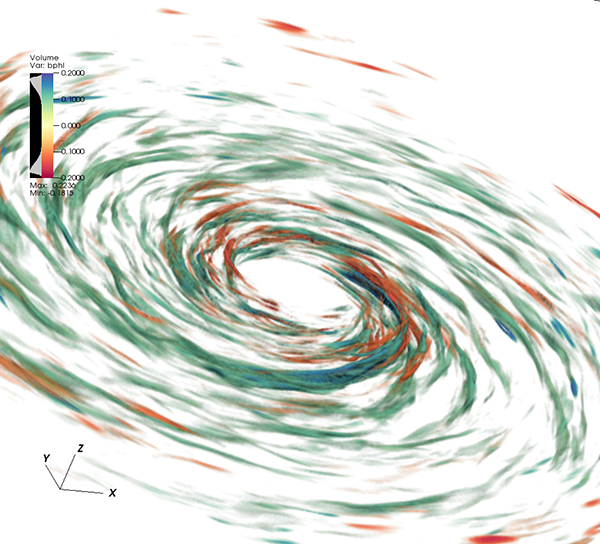ASTROPHYSICS
Simulations of Global Accretion Discs: Turbulent Transport and Dynamo Action
Principal Investigator:
Gianluigi Bodo
Affiliation:
INAF Astrophysical Observatory of Torino (Italy)
Local Project ID:
PRA057
HPC Platform used:
JUQUEEN of JSC
Date published:
Accretion discs can power some of the most energetic phenomena in the universe and understanding how they work is very important for the comprehension of different astrophysical problems like how stars are formed or what happens in the central cores of galaxies.
Accretion is the process through which matter gradually falls on a central object, typically forming a disc. Accretion discs are ubiquitous in the universe: They can be found in the nuclei of galaxies, around supermassive black holes, and around stars both at the beginning and at the end of their life. As the matter gradually accretes on the central object, gravitational energy is released, generating heat and radiation that we can observe.
Accretion discs can power some of the most energetic phenomena in the universe and understanding how they work is very important for the comprehension of different astrophysical problems like how stars are formed or what happens in the central cores of galaxies. The matter in the disc orbits around the central object like a planet around the Sun and it would continue forever if there didn’t exist a way to extract its angular momentum. For this reason, understanding the process of angular momentum extraction is fundamental for determining the mass accretion rate and the disc luminosity. Friction between adjacent rings of the disc, moving at different angular speed, can provide a way to extract angular momentum, but this process is much too slow and the resulting luminosities are well below those that are observed. Friction must then be enhanced by turbulent motions and, in order to develop turbulence, the disc must be magnetized. On the other hand, turbulence has to regenerate the magnetic field it needs to develop, otherwise it dies and accretion stops, unless an external magnetic field is provided.
The analysis of these complex processes can be done only through numerical simulations on the most powerful supercomputers. You can either follow the rotation of a small portion of the disc at very high resolution, in order to capture the turbulence at very small scale, or you can study at lower resolution the global disc. In a simulation project enabled through the Partnership for Advanced Computing in Europe (PRACE) on HPC system JUQUEEN of JSC, the scientists followed both approaches. First, looking at a small patch of the disc, they studied how the heat generated inside the disc is carried out to the surface to be radiated and the researchers discovered that this is accomplished by convection, very much like in a pot of boiling water. Furthermore, the presence of convection helps turbulent motions to regenerate magnetic field and thus enhances the overall efficiency of the accretion process. The global disc simulations show a similar convective behavior and how it changes with radial distance from the central body, furthermore it shows the formation of a spiral structure of the magnetic field.
This project has been successful in adding a new tile in the comprehension of how the interplay between turbulence, magnetic field generation, energy transport by convection makes accretion work in the most diverse astrophysical environments.

Artist view of an accretion disk.
Copyright: NASA E/PO - Sonoma State University, Aurore Simonnet (http://epo.sonoma.edu/)
The figure shows the relation between the global disc simulations (on the right) and the local patch simulation (on the left). The color scale represents the temperature distribution, lighter regions are hotter, while darker regions are cooler. The top surface shows the pattern of convective cells, lighter regions are where the hotter material is flowing upwards, while the darker regions are where the cooler material is flowing down.
Copyright: NAF Astrophysical Observatory of Torino, ItalyFull view of the global disc showing convective cells.
Zoom on the central part, again showing convective cells.

Gianluigi Bodo (INAF Astrophysical Observatory of Torino– Italy)
Fausto Cattaneo (Computation Institute University of Chicago – USA)
Andrea Mignone (Physics Department University of Torino – Italy)
Paola Rossi (INAF Astrophysical Observatory of Torino– Italy)
e-mail: bodo@oato.inaf.it
Februar 2014
JSC Project ID: PRA057